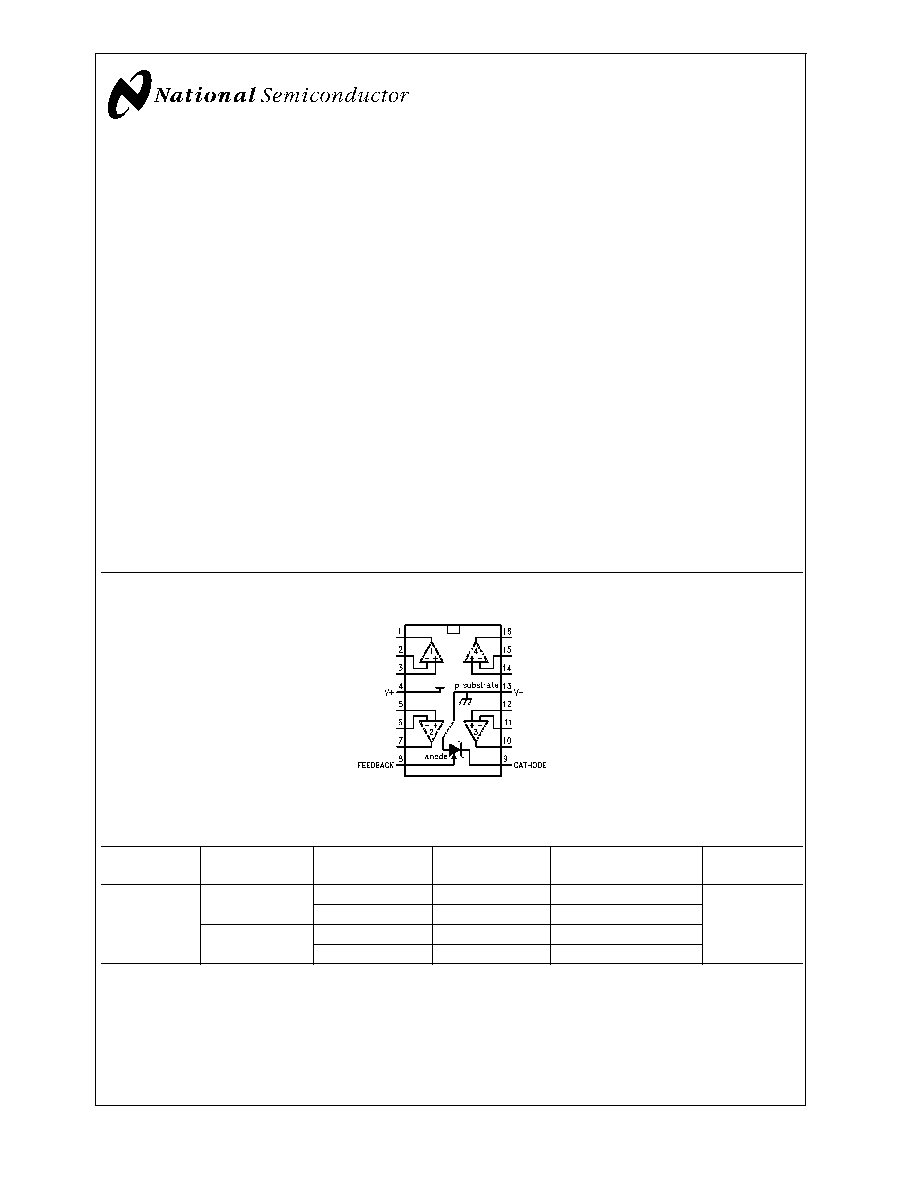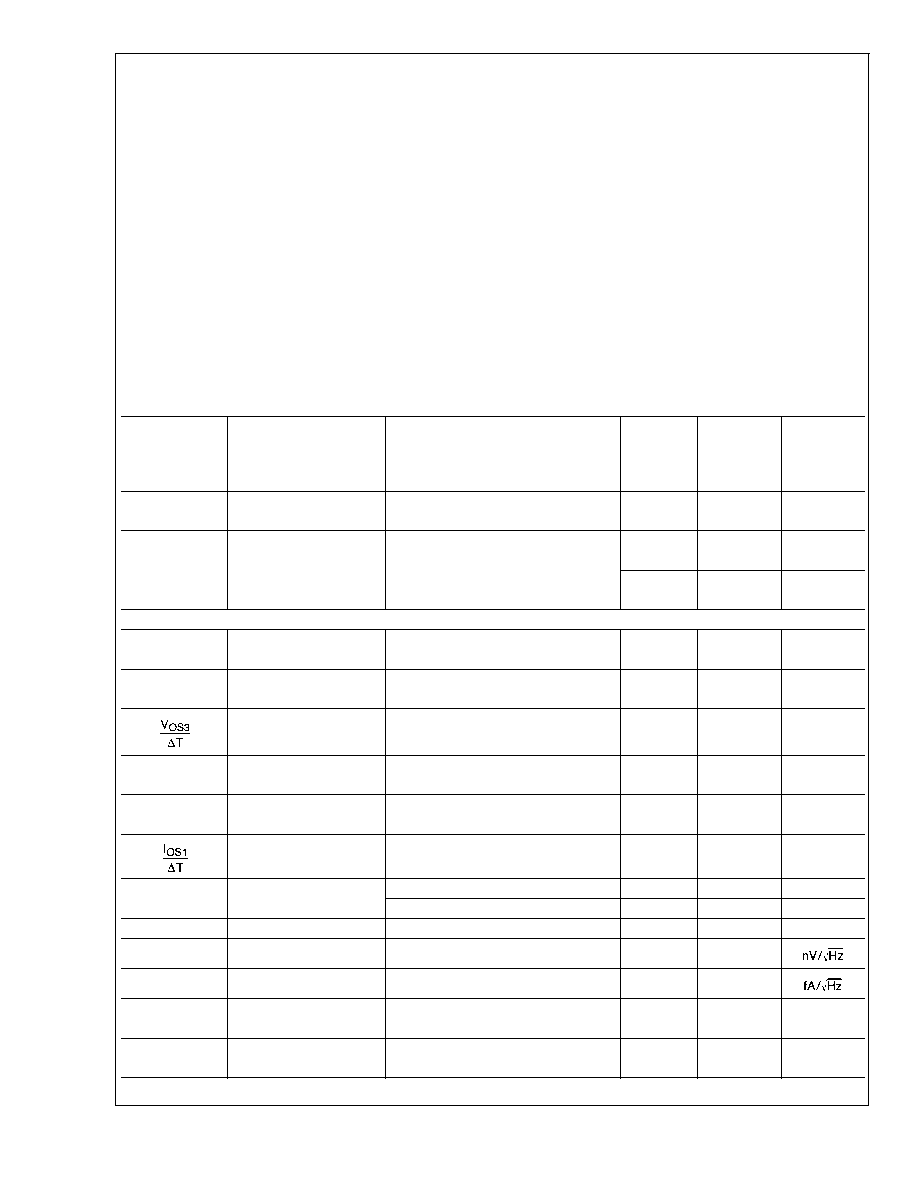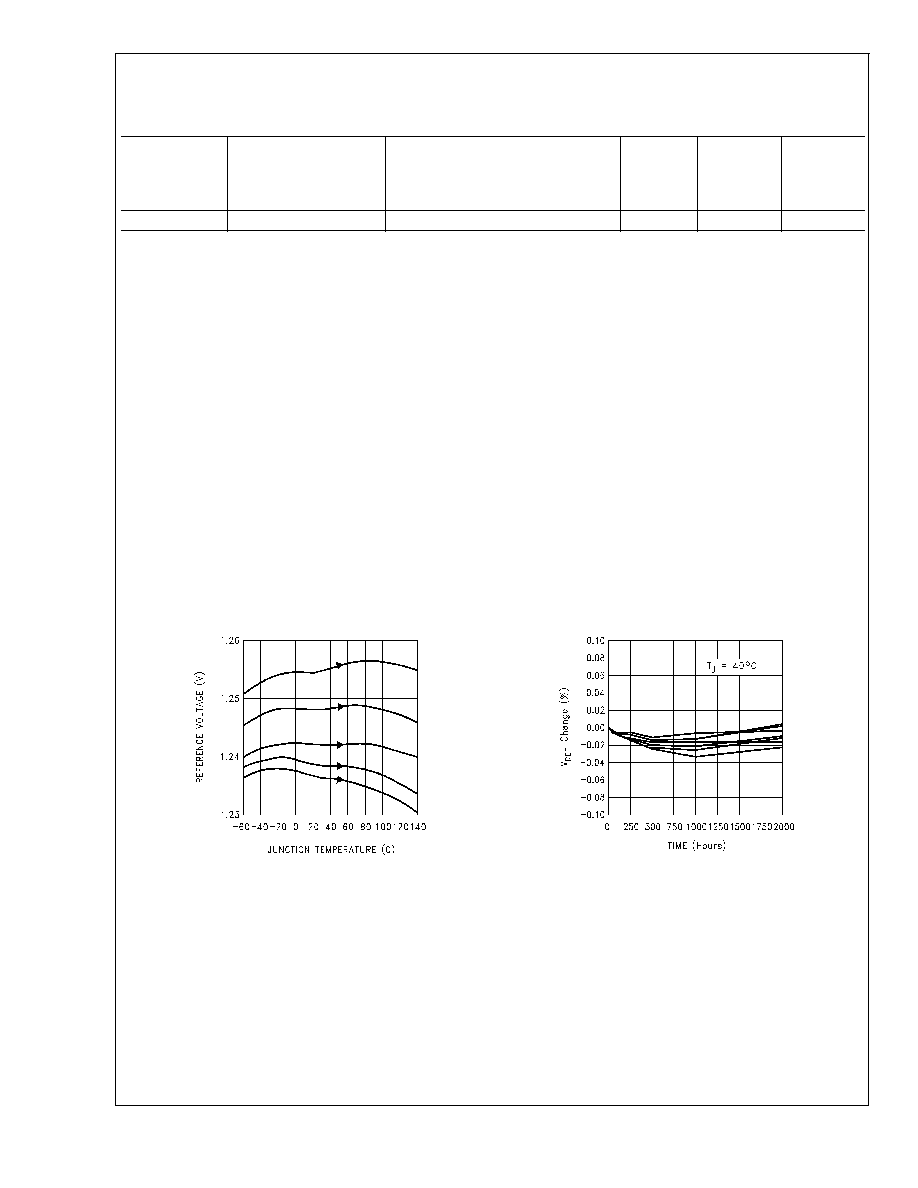
LM614
Quad Operational Amplifier and Adjustable Reference
General Description
The LM614 consists of four op-amps and a programmable
voltage reference in a 16-pin package. The op-amp
out-performs most single-supply op-amps by providing
higher speed and bandwidth along with low supply current.
This device was specifically designed to lower cost and
board space requirements in transducer, test, measurement
and data acquisition systems.
Combining a stable voltage reference with four wide output
swing op-amps makes the LM614 ideal for single supply
transducers, signal conditioning and bridge driving where
large common-mode-signals are common. The voltage ref-
erence consists of a reliable band-gap design that maintains
low dynamic output impedance (1
typical), initial tolerance
(2.0%), and the ability to be programmed from 1.2V to 5.0V
via two external resistors. The voltage reference is very
stable even when driving large capacitive loads, as are
commonly encountered in CMOS data acquisition systems.
As a member of National's new Super-Block
TM
family, the
LM614 is a space-saving monolithic alternative to a multichip
solution, offering a high level of integration without sacrificing
performance.
Features
Op Amp
n
Low operating current:
450µA
n
Wide supply voltage range:
4V to 36V
n
Wide common-mode range:
V
-
to (V
+
- 1.8V)
n
Wide differential input voltage:
±
36V
Reference
n
Adjustable output voltage:
1.2V to 5.0V
n
Initial tolerance:
±
2.0%
n
Wide operating current range:
17µA to 20mA
n
Tolerant of load capacitance
Applications
n
Transducer bridge driver and signal processing
n
Process and mass flow control systems
n
Power supply voltage monitor
n
Buffered voltage references for A/D's
Connection Diagram
00932601
Ordering Information
Package
Temperature
Range
Part Number
Package Marking
Transport Media
NSC Drawing
16-Pin Wide
Body SOIC
0∞C to 70∞C
LM614CWM
LM614CWM
Rails
M16B
LM614CWMX
LM614CWM
1k Units Tape and Reel
-40∞C to 85∞C
LM614IWM
LM614IWM
Rails
LM614IWMX
LM614IWM
1k Units Tape and Reel
Super-Block
TM
is a trademark of National Semiconductor Corporation.
December 2001
LM614
Quad
Operational
Amplifier
and
Adjustable
Reference
© 2001 National Semiconductor Corporation
DS009326
www.national.com

Absolute Maximum Ratings
(Note 1)
If Military/Aerospace specified devices are required,
please contact the National Semiconductor Sales Office/
Distributors for availability and specifications.
Voltage on Any Pins except V
R
(referred to V
-
pin)
(Note 2)
36V (Max)
(Note 3)
-0.3V (Min)
Current through Any Input Pin &
V
R
Pin
±
20 mA
Differential Input Voltage
LM614I
±
36V
LM614C
±
32V
Storage Temperature Range
-65∞C
T
J
+150∞C
Maximum Junction Temperature
150∞C
Thermal Resistance,
Junction-to-Ambient (Note 4)
150∞C
Soldering Information (Soldering,
10 sec.)
220∞C
ESD Tolerance (Note 5)
±
1kV
Operating Temperature Range
LM614I
-40∞C
T
J
+85∞C
LM614C
0∞C
T
J
+70∞C
Electrical Characteristics
These specifications apply for V
-
= GND = 0V, V
+
= 5V, V
CM
= V
OUT
= 2.5V, I
R
= 100µA, FEEDBACK pin shorted to GND,
unless otherwise specified. Limits in standard typeface are for T
J
= 25∞C; limits in Boldface type apply over the Operating
Temperature Range .
Symbol
Parameter
Conditions
Typ
(Note 6)
LM614I
LM614C
Limits
(Note 7)
Units
I
S
Total Supply
R
LOAD
=
,
450
1000
µA max
Current
4V
V
+
36V (32V for LM614C)
550
1070
µA max
V
S
Supply Voltage Range
2.2
2.8
V min
2.9
3
V min
46
32
V max
43
32
V max
OPERATIONAL AMPLIFIER
V
OS1
V
OS
Over Supply
4V
V
+
36V
1.5
5.0
mV max
(4V
V
+
32V for LM614C)
2.0
7.0
mV max
V
OS2
V
OS
Over V
CM
V
CM
= 0V through V
CM
=
1.0
5.0
mV max
(V
+
- 1.8V), V
+
= 30V
1.5
7.0
mV max
Average V
OS
Drift
(Note 7)
15
µV/∞C
max
I
B
Input Bias Current
10
35
nA max
11
40
nA max
I
OS
Input Offset Current
0.2
4
nA max
0.3
5
nA max
Average Offset
Drift Current
4
pA/∞C
R
IN
Input Resistance
Differential
1800
M
Common-Mode
3800
M
C
IN
Input Capacitance
Common-Mode Input
5.7
pF
e
n
Voltage Noise
f = 100 Hz, Input Referred
74
I
n
Current Noise
f = 100 Hz, Input Referred
58
CMRR
Common-Mode
V
+
= 30V, 0V
V
CM
(V
+
- 1.8V),
95
75
dB min
Rejection Ratio
CMRR = 20 log (
V
CM
/
V
OS
)
90
70
dB min
PSRR
Power Supply
4V
V
+
30V, V
CM
= V
+
/2,
110
75
dB min
Rejection Ratio
PSRR = 20 log (
V
+
/
V
OS
)
100
70
dB min
LM614
www.national.com
2

Electrical Characteristics
(Continued)
These specifications apply for V
-
= GND = 0V, V
+
= 5V, V
CM
= V
OUT
= 2.5V, I
R
= 100µA, FEEDBACK pin shorted to GND,
unless otherwise specified. Limits in standard typeface are for T
J
= 25∞C; limits in Boldface type apply over the Operating
Temperature Range .
Symbol
Parameter
Conditions
Typ
(Note 6)
LM614I
LM614C
Limits
(Note 7)
Units
V
RO
= V
R
Note 1: Absolute maximum ratings indicate limits beyond which damage to the component may occur. Electrical specifications do not apply when operating the
device beyond its rated operating conditions.
Note 2: Input voltage above V
+
is allowed.
Note 3: More accurately, it is excessive current flow, with resulting excess heating, that limits the voltages on all pins. When any pin is pulled a diode drop below
V
-
, a parasitic NPN transistor turns ON. No latch-up will occur as long as the current through that pin remains below the Maximum Rating. Operation is undefined
and unpredictable when any parasitic diode or transistor is conducting.
Note 4: Junction temperature may be calculated using T
J
= T
A
+ P
D
jA
. The given thermal resistance is worst-case for packages in sockets in still air. For packages
soldered to copper-clad board with dissipation from one comparator or reference output transistor, nominal
jA
is 90∞C/W for the WM package.
Note 5: Human body model, 100 pF discharged through a 1.5 k
resistor.
Note 6: Typical values in standard typeface are for T
J
= 25∞C; values in boldface type apply for the full operating temperature range. These values represent the
most likely parametric norm.
Note 7: All limits are guaranteed at room temperature (standard type face) or at operating temperature extremes (bold type face).
Note 8: Slew rate is measured with op amp in a voltage follower configuration. For rising slew rate, the input voltage is driven from 5V to 25V, and the output voltage
transition is sampled at 10V and
@
20V. For falling slew rate, the input voltage is driven from 25V to 5V, and the output voltage transition is sampled at 20V and 10V.
Note 9: V
R
is the Cathode-feedback voltage, nominally 1.244V.
Note 10: Average reference drift is calculated from the measurement of the reference voltage at 25∞C and at the temperature extremes. The drift, in ppm/∞C, is
10
6
∑
V
R
/(V
R[25∞C]
∑
T
J
), where
V
R
is the lowest value subtracted from the highest, V
R[25∞C]
is the value at 25∞C, and
T
J
is the temperature range. This parameter
is guaranteed by design and sample testing.
Note 11: Hysteresis is the change in V
R
caused by a change in T
J
, after the reference has been "dehysterized". To dehysterize the reference; that is minimize the
hysteresis to the typical value, cycle its junction temperature in the following pattern, spiraling in toward 25∞C: 25∞C, 85∞C, -40∞C, 70∞C, 0∞C, 25∞C.
Note 12: Low contact resistance is required for accurate measurement.
Typical Performance Characteristics (Reference)
T
J
= 25∞C, FEEDBACK pin shorted to V
-
= 0V, unless otherwise noted
Reference Voltage vs.
Temperature on 5 Representative Units
Reference Voltage Drift
00932647
00932648
LM614
www.national.com
4

Typical Performance Characteristics (Reference)
T
J
= 25∞C, FEEDBACK pin shorted to V
-
= 0V, unless otherwise noted (Continued)
Accelerated Reference Voltage Drift vs. Time
Reference Voltage vs. Current and Temperature
00932649
00932650
Reference Voltage vs. Current and Temperature
Reference Voltage vs. Reference Current
00932651
00932652
Reference Voltage vs. Reference Current
Reference AC Stability Range
00932653
00932654
LM614
www.national.com
5




